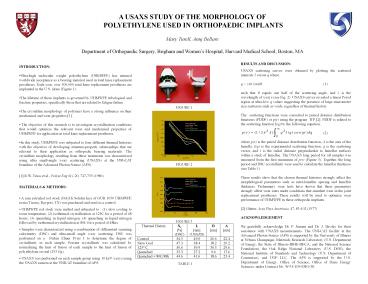A1258568572xhvJr PowerPoint PPT Presentation
1 / 1
Title: A1258568572xhvJr
1
A USAXS STUDY OF THE MORPHOLOGY OF
POLYETHYLENE USED IN ORTHOPAEDIC IMPLANTS Mary
Turell, Anuj Bellare Department of Orthopaedic
Surgery, Brigham and Womens Hospital, Harvard
Medical School, Boston, MA
RESULTS AND DISCUSSION USAXS scattering curves
were obtained by plotting the scattered intensity
I versus q where q (4p/?)sin? (1) such
that ? equals one half of the scattering angle,
and ? is the wavelength of x-rays (see Fig. 2).
USAXS curves revealed a linear Porod region at
ultra-low q values suggesting the presence of
large micrometer size scatterers such as voids,
regardless of thermal history. The scattering
functions were converted to paired distance
distribution functions (PDDF) or p(r) using the
program ITP 2. PDDF is related to the
scattering function I(q) by the following
equation (2) where p(r) is the paired
distance distribution function, A is the area of
the lamella, I(q) is the experimental scattering
function, q is the scattering vector, and r is
the radial distance perpendicular to lamellar
surfaces within a stack of lamellae. The USAXS
long period for all samples was measured from the
first maximum of p(r) (Figure 3). Together, the
long period and DSC crystallinity were used to
calculate the lamellar thickness (see Table
1) These results show that the chosen thermal
histories strongly affect the morphological
parameters such as inter-lamellar spacing and
lamellar thickness. Preliminary wear tests have
shown that these parameters strongly affect wear
rates under conditions that simulate wear in the
joint replacement prostheses. These results will
be used to optimize wear performance of UHMWPE in
these orthopedic implants. 2 Glatter, Acta
Phys.Austriaca, 47, 83-102 (1977) ACKNOWLEDGEMENT
We gratefully acknowledge Dr. P. Jemian and Dr.
J. Ilavsky for their assistance with USAXS
measurements. The UNI-CAT facility at the
Advanced Photon Source (APS) is supported by the
University of Illinois at Urbana Champaign,
Materials Research Laboratory (U.S. Department of
Energy, the State of Illinois-IBHE-HECA, and the
National Science Foundation), the Oak Ridge
National Laboratory (U.S. DOE), the National
Institute of Standards and Technology (U.S.
Department of Commerce), and UOP LLC. The APS is
supported by the U.S. Department of Energy,
Office of Science, Office of Basic Energy
Sciences, under Contract No. W-31-109-ENG-38.
- INTRODUCTION
- Ultra-high molecular weight polyethylene (UHMWPE)
has attained worldwide acceptance as a bearing
material used in total knee replacement
prostheses. Each year, over 300,000 total knee
replacement prostheses are implanted in the U.S.
alone (Figure 1). - The lifetime of these implants is governed by
UHMWPE tribological and fracture properties,
specifically those that are related to fatigue
failure. - The crystalline morphology of polymers have a
strong influence on their mechanical and wear
properties 1. - The objective of this research is to investigate
crystallization conditions that would optimize
the relevant wear and mechanical properties of
UHMWPE for application in total knee replacement
prostheses. - In this study, UHMWPE was subjected to four
different thermal histories with the objective of
developing structure-property relationships that
are relevant to their application as orthopedic
bearing materials. The crystalline morphology
resulting from these treatments was characterized
using ultra small-angle x-ray scattering (USAXS)
at the UNI-CAT beamline of the Advanced Photon
Source (APS). - 1 R.W. Truss et al., Polym Eng Sci, 20, 747-755
(1980). - MATERIALS METHODS
- A ram extruded rod stock (PolyHi Solidur Inc) of
GUR 1050 UHMWPE resin (Ticona, Bayport, TX) was
purchased and used as a control. - UHMWPE rod stock were melted and subjected to
(1) slow cooling to room temperature, (2)
isothermal crystallization at 125C for a period
of 48 hours, (3) quenching in liquid nitrogen,
(4) quenching in liquid nitrogen followed by
isothermal crystallization at 80C for a period of
48hrs. - Samples were characterized using a combination
of differential scanning calorimetry (DSC) and
ultra-small angle x-ray scattering. DSC was
performed on a Perkin Elmer Pyris 1 to determine
the degree of crystallinity in each sample.
Percent crystallinity was calculated by
normalizing the heat of fusion of each sample to
the heat of fusion of polyethylene crystal (293
J/g).
FIGURE 1
FIGURE 2
FIGURE 3
TABLE 1

